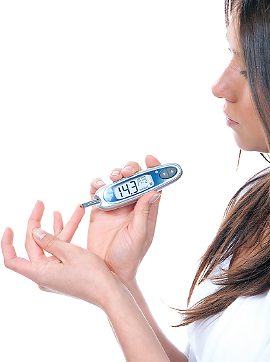Eating Disorders May Pose Greater Risk in Type 1 Diabetes
Abstract
Clinicians must discern whether poor diabetic control is just that, or something more troubling in patients with type 1 diabetes.
When treating patients with type 1 diabetes (DM-1), clinicians often focus on the potential for microvascular and macrovascular complications, such as retinopathy and cardiovascular disease. But many DM-1 patients are at much greater risk for a different complication: an eating disorder.
DM-1 is among the most common chronic illnesses of childhood, with a prevalence of 0.1 percent in the general population, affecting both genders equally. “The highest risk for an eating disorder appears when patients are diagnosed with DM-1 between ages 7 and 18 years,” explained Erin Sterenson, M.D., a psychosomatic medicine fellow at the Mayo Clinic in Rochester, Minn., who led the Academy of Psychosomatic Medicine’s seminar “Eating Disorders Through the Lifespan” at APA’s 2013 annual meeting in San Francisco in May.

Routine methods for monitoring and controlling blood glucose levels can be mistaken for signs of an eating disorder in DM-1 patients.
Sterenson explained that although the prevalence of anorexia nervosa in DM-1 patients is thought to be equal to that in non-DM-1 patients—which she noted are between 0 percent and 3.2 percent—the prevalence of bulimia nervosa is much higher, up to 35 percent compared with 1 percent to 2 percent in the general population.
DM-1 patients with disordered eating, informally known as diabulimia, have an unusual and potentially dangerous method for purging calories at their disposal: insulin restriction or omission. When insulin is underdosed in these patients, muscle and fat are broken down into ketone bodies, sugar is unable to enter cells and be used for energy, and sugar (calories) is purged via urination, resulting in weight loss.
How common are eating disorders in DM-1 patients? Sterenson pointed out that studies suggest DM-1 patients are two to four times more likely to experience an eating disorder than are nondiabetics. Consistent with other forms of eating disorders, 95 percent of DM-1 patients with eating disorders are female, and 45 percent are aged 15 and 30.
Rates of insulin omission also appear to peak between the ages of 15 and 30 in diabulimic patients. But detecting an eating disorder in a DM-1 patient can be challenging, Sterenson said. There are many legitimate reasons why DM-1 patients might restrict their insulin intake, such as simply forgetting to dose themselves. Fear of hypoglycemia and its social implications, uncertainty about carbohydrate counts, increased physical activity, and limited access to food or medical supplies in certain settings can also result in insulin restriction.
Identifying DM-1 patients with eating disorders is made even more complicated by the lack of a validated screening tool. Tools designed for non-DM-1 patients can be misleading. “The general screening tools often ask questions that most of our patients with DM-1 are encouraged to incorporate into their daily life, such as being aware of calorie content and carbohydrate content,” said Sterenson. “On the other hand, these screening measures don’t evaluate patients for insulin omission or underdosing.”
Normal aspects of management of DM-1 can also create risk factors for an eating disorder. Dietary restraint and preoccupation with food, disregard for hunger and satiety cues, perceived and actual loss of control and independence, and a focus on exercise are all aspects of daily management of DM-1, as well as potential triggers for an eating disorder.
But there are signs and symptoms that should raise a clinician’s “index of suspicion” for an eating disorder in a DM-1 patient, Sterenson emphasized, including extreme concerns about body shape or weight, intense exercise regimens, and low-calorie meal plans. Unexplained elevations in HbA1c, repeated episodes of diabetic ketoacidosis, and resistance to treating hypoglycemia should also be investigated.
And while detection of an eating disorder in a DM-1 patient can be tricky, treatment and prevention are even more complicated, she noted. Psychotherapy, assessment and treatment of psychiatric comorbidities, and less-intensive dietary management are some appropriate approaches, but little information about the effectiveness of any specific treatment is available, and Sterenson stressed the need for greater focus on evaluating and treating diabulimic patients. “For many DM-1 patients, eating disorders present a much greater risk than the microvascular and macrovascular complications on which we so often focus,” she said. ■
To watch a video interview of Sterenson, go to http://www.youtube.com/watch?v=eAW5wqDxeyE.



